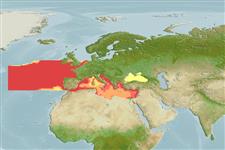>
Beloniformes (Needle fishes) >
Belonidae (Needlefishes)
Etymology: Belone: Greek, belone = needle; any fish with sharp pointed snout; also Pierre Belon, 1517-64, French zoologist born in Le Mans. Professor at the College de France, author of " La nature et diversité des poissons", 1551 (Ref. 45335).
Environment: milieu / climate zone / depth range / distribution range
বাস্তুসংস্থান
সামুদ্রিক; গভীরতার পরিসীমা 0 - ? m. Temperate; 54°N - 30°N
Eastern Atlantic: southern Ireland, Spain, Portugal including scattered records in the Mediterranean. Previously confused with Belone belone.
আকৃতি / ওজন / Age
Maturity: Lm ? range ? - ? cm
Max length : 41.8 cm TL পুরুষ/ লিঙ্গ অনিধর্ারিত ; (Ref. 118193)
Oviparous (Ref. 205). Eggs may be found attached to objects in the water by tendrils on the egg's surface (Ref. 205).
Life cycle and mating behavior
পরিপক্কতা | প্রজনন | ডিম ছাড়া | ডিমসমূহ | ডিম্বধারন ক্ষমতা | শুককীট
Collette, B.B. and N.V. Parin, 1986. Belonidae. p. 604-609. In P.J.P. Whitehead, M.-L. Bauchot, J.-C. Hureau, J. Nielsen and E. Tortonese (eds.) Fishes of the north-eastern Atlantic and the Mediterranean, Volume 2. Unesco, Paris. (Ref. 5505)
IUCN Red List Status (Ref. 130435)
Threat to humans
Harmless
Human uses
আরো তথ্য
Age/Sizeবৃদ্ধিLength-weightLength-lengthLength-frequenciesমরফোমেট্রিক্সবহিঃ অঙ্গ সংস্থানশুককীট শুককীটের সত্রিুয়তা নির্বাচন প্রাচুর্য BRUVS
সূত্র সংখ্যা এ্যাকুয়াকালচার (জলজ পালন) এ্যাকুয়াকালচার নকশা বংশ বংশানুগতিবিদ্যাElectrophoresesউতরাধিকার সুত্রে পাওয়া যোগ্যতারোগ প্রক্রিয়াজাতকরণ NutrientsMass conversion
সহযোগী ছবি সমূহStamps, Coins Misc.শব্দ ক্রোমোজোমের ধরণ গতি সাতাঁরের কায়দা ফুলকা এলাকাOtolithsমস্তিস্ক সমূহদৃষ্টি
হাতিয়ার
Special reports
Download XML
ইন্টারনেট সুত্র
Estimates based on models
Preferred temperature (Ref.
123201): 10.9 - 20.3, mean 16.5 °C (based on 3597 cells).
Phylogenetic diversity index (Ref.
82804): PD
50 = 0.6250 [Uniqueness, from 0.5 = low to 2.0 = high].
Bayesian length-weight: a=0.00126 (0.00056 - 0.00281), b=3.11 (2.93 - 3.29), in cm total length, based on LWR estimates for this (Sub)family-body shape (Ref.
93245).
ট্রফিক পর্যায়ে (Ref.
69278): 4.0 ±0.6 se; based on size and trophs of closest relatives
স্থিতিস্থাপক (Ref.
120179): উচ্চ, সর্বনিম্ন প্রজন দ্বিগুনের সময় ১৫ মাস (Preliminary K or Fecundity.).
Fishing Vulnerability (Ref.
59153): Low to moderate vulnerability (32 of 100).
